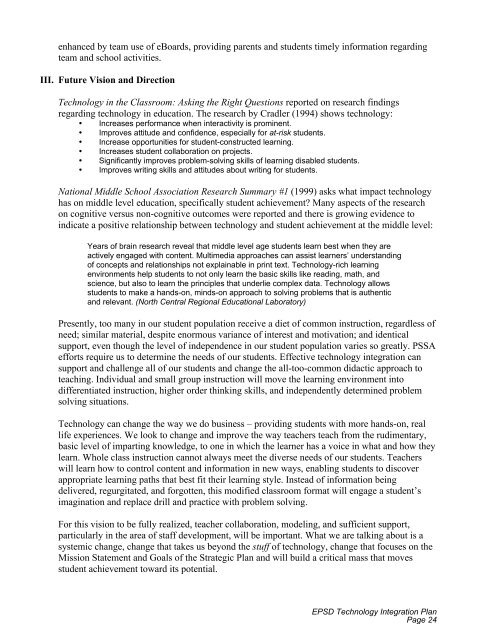EPSDtechintplan2004
EPSDtechintplan2004
EPSDtechintplan2004
Create successful ePaper yourself
Turn your PDF publications into a flip-book with our unique Google optimized e-Paper software.
enhanced by team use of eBoards, providing parents and students timely information regarding<br />
team and school activities.<br />
III. Future Vision and Direction<br />
Technology in the Classroom: Asking the Right Questions reported on research findings<br />
regarding technology in education. The research by Cradler (1994) shows technology:<br />
• Increases performance when interactivity is prominent.<br />
• Improves attitude and confidence, especially for at-risk students.<br />
• Increase opportunities for student-constructed learning.<br />
• Increases student collaboration on projects.<br />
• Significantly improves problem-solving skills of learning disabled students.<br />
• Improves writing skills and attitudes about writing for students.<br />
National Middle School Association Research Summary #1 (1999) asks what impact technology<br />
has on middle level education, specifically student achievement? Many aspects of the research<br />
on cognitive versus non-cognitive outcomes were reported and there is growing evidence to<br />
indicate a positive relationship between technology and student achievement at the middle level:<br />
Years of brain research reveal that middle level age students learn best when they are<br />
actively engaged with content. Multimedia approaches can assist learners’ understanding<br />
of concepts and relationships not explainable in print text. Technology-rich learning<br />
environments help students to not only learn the basic skills like reading, math, and<br />
science, but also to learn the principles that underlie complex data. Technology allows<br />
students to make a hands-on, minds-on approach to solving problems that is authentic<br />
and relevant. (North Central Regional Educational Laboratory)<br />
Presently, too many in our student population receive a diet of common instruction, regardless of<br />
need; similar material, despite enormous variance of interest and motivation; and identical<br />
support, even though the level of independence in our student population varies so greatly. PSSA<br />
efforts require us to determine the needs of our students. Effective technology integration can<br />
support and challenge all of our students and change the all-too-common didactic approach to<br />
teaching. Individual and small group instruction will move the learning environment into<br />
differentiated instruction, higher order thinking skills, and independently determined problem<br />
solving situations.<br />
Technology can change the way we do business – providing students with more hands-on, real<br />
life experiences. We look to change and improve the way teachers teach from the rudimentary,<br />
basic level of imparting knowledge, to one in which the learner has a voice in what and how they<br />
learn. Whole class instruction cannot always meet the diverse needs of our students. Teachers<br />
will learn how to control content and information in new ways, enabling students to discover<br />
appropriate learning paths that best fit their learning style. Instead of information being<br />
delivered, regurgitated, and forgotten, this modified classroom format will engage a student’s<br />
imagination and replace drill and practice with problem solving.<br />
For this vision to be fully realized, teacher collaboration, modeling, and sufficient support,<br />
particularly in the area of staff development, will be important. What we are talking about is a<br />
systemic change, change that takes us beyond the stuff of technology, change that focuses on the<br />
Mission Statement and Goals of the Strategic Plan and will build a critical mass that moves<br />
student achievement toward its potential.<br />
EPSD Technology Integration Plan<br />
Page 24


